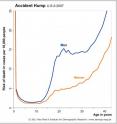Boys reach sexual maturity younger and younger
Boys are maturing physically earlier than ever before. The age of sexual maturity has been decreasing by about 2.5 months each decade at least since the middle of the 18th century. Joshua Goldstein, director of the Max Planck Institute for Demographic Research in Rostock (MPIDR), has used mortality data to demonstrate this trend, which until now was difficult to decipher. What had already been established for girls now seems to also be true for boys: the time period during which young people are sexually mature but socially not yet considered adults is expanding. "The reason for earlier maturity for boys, as with girls, is probably because nutrition and disease environments are getting more favourable for it," says demographer Joshua Goldstein. It has long been documented by medical records that girls are experiencing their first menstruation earlier and earlier. But comparable data analysis for boys did not exist. Goldstein resolved this gap by studying demographic data related to mortality. When male hormone production during puberty reaches a maximum level the probability of dying jumps up. This phenomenon, called the "accident hump," exists in almost all societies and is statistically well documented.
Goldstein discovered that the maximum mortality value of the accident hump shifted to earlier age by 2.5 months for each decade since the mid-1700s, or just over two years per century. Accordingly, the age of boys' sexual maturity decreased at the same rate. Essentially, the data showed that the age of sexual maturity is getting younger and younger since the accident hump is occurring earlier and earlier. (Research included data for Sweden, Denmark, Norway, Great Britain and Italy. Since 1950 the data is no longer clear but indicates stagnation.) The maximum of the accident hump occurs in the late phase of puberty, after males reach reproductive capability and their voice changes.
When boys get physically mature they take more risks and the risk of death increases
The accident hump, which also exists among male apes, occurs because young men participate in particularly risky behaviour when the release of the hormone testosterone reaches its maximum. Dangerous and reckless shows of strength, negligence, and a high propensity to violence lead to an increased number of fatal accidents. The probability remains low, but the rate jumps up considerably (see graphic).
In respect to the developmental stage of the body "being 18 today is like being 22 in 1800" says Joshua Goldstein. He sees the main causes as better nutrition and an improved resilience against diseases. Because the decline began long before the intervention of the automobile (accompanied by a high risk of accident) it appears that the shift in age of maturity is biological, and not related to technological advancements or social activities. When the use of automobiles or guns became common no significant effect on the data could be seen.
Albeit giving evidence for the age shift only indirectly via mortality data, Joshua Goldstein underlines the importance of its biological meaning: "Researchers see for the first time how females and males have been equally responsive to changes in the environment."
The onset of biological versus social adulthood is drifting apart
"The biological and social phases in the lives of young people are drifting apart ever stronger," says Josh Goldstein. "While adolescents become adults earlier in a biological sense, they reach adulthood later regarding their social and economic roles." Life cycle research shows that for more than half a century the age at which people marry, have children, start their careers and become financially independent from their parents continues to rise.
According to Joshua Goldstein, this doesn't only extend the period of physical adulthood during which young people do not yet have children. "Important decisions in life are being made with an increasing distance from the recklessness of youth." The demographer points out that it remains unclear whether the "high-risk phase" of adolescence becomes more dangerous for males because it starts earlier. While younger men are less mentally and socially mature, parents also tend to supervise their children more closely when they are younger.
Source: Max-Planck-Gesellschaft
Other sources
- Boys reach sexual maturity younger and younger: Phase between being physically but not socially adult is getting longerfrom Science DailyThu, 18 Aug 2011, 20:31:24 UTC
- Boys Reaching Sexual Maturity Earlier Than Everfrom Live ScienceThu, 18 Aug 2011, 20:00:29 UTC
- Boys reach sexual maturity younger and youngerfrom PhysorgThu, 18 Aug 2011, 14:00:29 UTC
